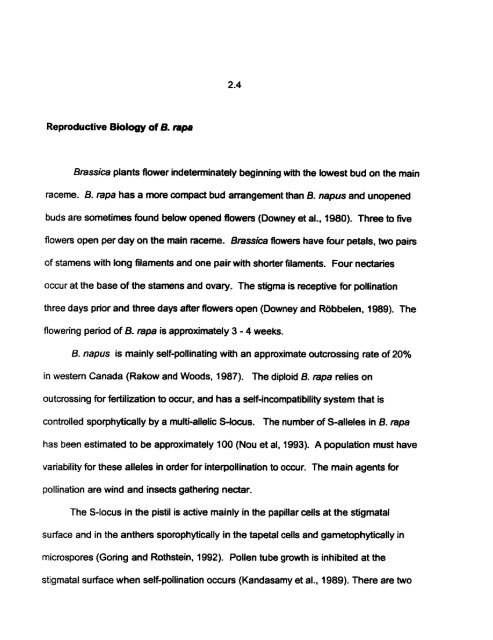The Application of Ooubled Haploid Plants to Population ... - MSpace
The Application of Ooubled Haploid Plants to Population ... - MSpace
The Application of Ooubled Haploid Plants to Population ... - MSpace
You also want an ePaper? Increase the reach of your titles
YUMPU automatically turns print PDFs into web optimized ePapers that Google loves.
Reproductive Biology <strong>of</strong> B. tapa<br />
Brassica plants flower indetemiinately beginning with the lowest bud on the main<br />
racerne. B. rapa has a more compact bud arrangement than B. napus and unopened<br />
buds are sometimes found below opened flowers (Downey et al.. 1980). Three <strong>to</strong> five<br />
flowers open per day on the main raceme. Brassica flowers have four petals. two pairs<br />
<strong>of</strong> starnens with long filaments and one pair with shorter filaments. Four nectaries<br />
occur at the base <strong>of</strong> the stamens and ovary. <strong>The</strong> stigma is receptive for pollination<br />
three days prior and three days after fiowers open (Downey and Robbelen, 1989). <strong>The</strong><br />
flowering period <strong>of</strong> B. tapa is approximately 3 - 4 weeks.<br />
B. napus is mainly self-pollinating wîth an approximate outcrossing rate <strong>of</strong> 20%<br />
in western Canada (Rakow and Woods, 1987). <strong>The</strong> diploid B. rapa relies on<br />
outcrossing for fertilizaüon <strong>to</strong> omr, and has a self-incompatibility system that is<br />
controlled sporphytically by a multi-allelic S-locus. <strong>The</strong> number <strong>of</strong> S-alleles in B. rapa<br />
has been estirnated <strong>to</strong> be approximately 100 (Nou et al, 1993). A population must have<br />
variability for these alleles in order for interpollination <strong>to</strong> occur. <strong>The</strong> main agents for<br />
pollination are wind and insects gathering nectar.<br />
<strong>The</strong> S-locus in the pistil is active mainly in the papillar cells at the stigmatal<br />
surface and in the anthers sporophytically in the tapetal cells and game<strong>to</strong>phytically in<br />
microspores (Goring and Rothstein, 1992). Pollen tube growth is inhibited at the<br />
stigmatal surface when self-pollination occurs (Kandasarny et al., 1989). <strong>The</strong>re are two







![an unusual bacterial isolate from in partial fulf]lment for the ... - MSpace](https://img.yumpu.com/21942008/1/190x245/an-unusual-bacterial-isolate-from-in-partial-fulflment-for-the-mspace.jpg?quality=85)





![in partial fulfil]ment of the - MSpace - University of Manitoba](https://img.yumpu.com/21941988/1/190x245/in-partial-fulfilment-of-the-mspace-university-of-manitoba.jpg?quality=85)


